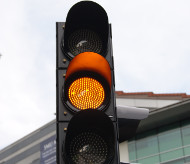5/21/2014
Virginia: Redflex Caught Using Violation CalculatorRed light camera vendor uses a spreadsheet to calculate profit based on engineering deficiencies such as short yellow time.

Redflex Traffic Systems uses a special spreadsheet to calculate precisely how much profit a city can expect from red light cameras on an intersection-by-intersection basis. WTKR-TV reported about the "violation calculator" that Redflex used to provide the city of Chesapeake, Virginia with the dollar figure it could expect after signing a contract with the Australian firm.
The violation calculator is a more refined version of the criteria red light camera companies have always used. In 2001, a team of attorneys in San Diego, California used a court subpoena to obtain a copy of the confidential site evaluation performed by vendor Lockheed Martin (which now operates as Xerox). The decisions on where cameras were installed were based on finding high volume, downhill approaches where the yellow time was less than 4 seconds (view document).
Redflex promised that within ten days of signing the contract, the firm would send the city a list of the most profitable intersections based on an eight-hour video assessment of each prime location.
"Completing a detailed video analysis will ensure that Redflex and the city truly develop and implement a comprehensive 'approach strategy' that will provide the city with detailed information for accurate fact-based decisions on possible program expansion efforts," the 2009 Redflex proposal explained.
The video survey is an old fashioned method of calculating profit, however. Redflex found that it could achieve 85 percent more accurate results with its violation calculator.
"Redflex has also developed an additional analysis approach that is truly unique to Redflex," the proposal explained. "Redflex sought the guidance of a renowned professor from Texas A&M University and the development of a 'Violation Calculator' that factors in not only the quantitative violation analysis, but the engineering factors at an approach level that would also influence driver behavior."
The factors measured include the yellow duration, traffic volume, the speed limit and 85th percentile approach speed, the percentage of heavy vehicles, whether the signals have backing plates and the average duration of the green signal. The shorter the yellow time, the less visible the signal and the more deficient the engineering, the greater number of tickets will be issued, and the greater the profit for the city.
Under Virginia law, it is illegal to base the compensation for a red light camera company on the number of tickets issued or the amount of money collected. During the proposal process, Redflex asked Chesapeake officials to explain the legality of the city's expectation not to ever have to pay for the camera program through a cost neutrality clause.
"It appears that 'cost neutral' compensation is directly correlated to the number of the violations issued and the collection of the related fines, ie., the 'monetary penalties imposed,'" Redflex Executive Vice President Cristina Weekes asked in a February 9, 2009 contracting addendum. "If the locality does not receive sufficient revenue from collected fines to pay the contractor, and then the contractor must reduce the fee. Thus it appears that 'cost neutral' compensation is based on both the number of violations and the monetary penalties imposed. What is the Chesapeake city attorney's opinion regarding code of Virginia 15.2-968.1 and whether or not 'cost neutral' compensation complies?"
The Redflex proposal also touted its winning of the contract to provide cameras in Chicago, Illinois as proof of the company's excellence, even though the real reason, according to federal prosecutors last week, was a $2 million bribery scheme to influence the city's contract selection.
"The evaluation process was extremely comprehensive and included reference checks, the assessment of each participating vendor's records of past performance and the specialized experience of each participating firm's personnel," the Redflex proposal boasted. "There could be no better confirmation of the legitimacy, credibility, technological superiority and undisputed market leadership of Redflex Traffic Systems than being awarded the largest photo enforcement program in the world in a highly competitive bid process."
Excerpts from the Redflex proposal to the city of Chesapeake is available in an 800k PDF file at the source link below.


